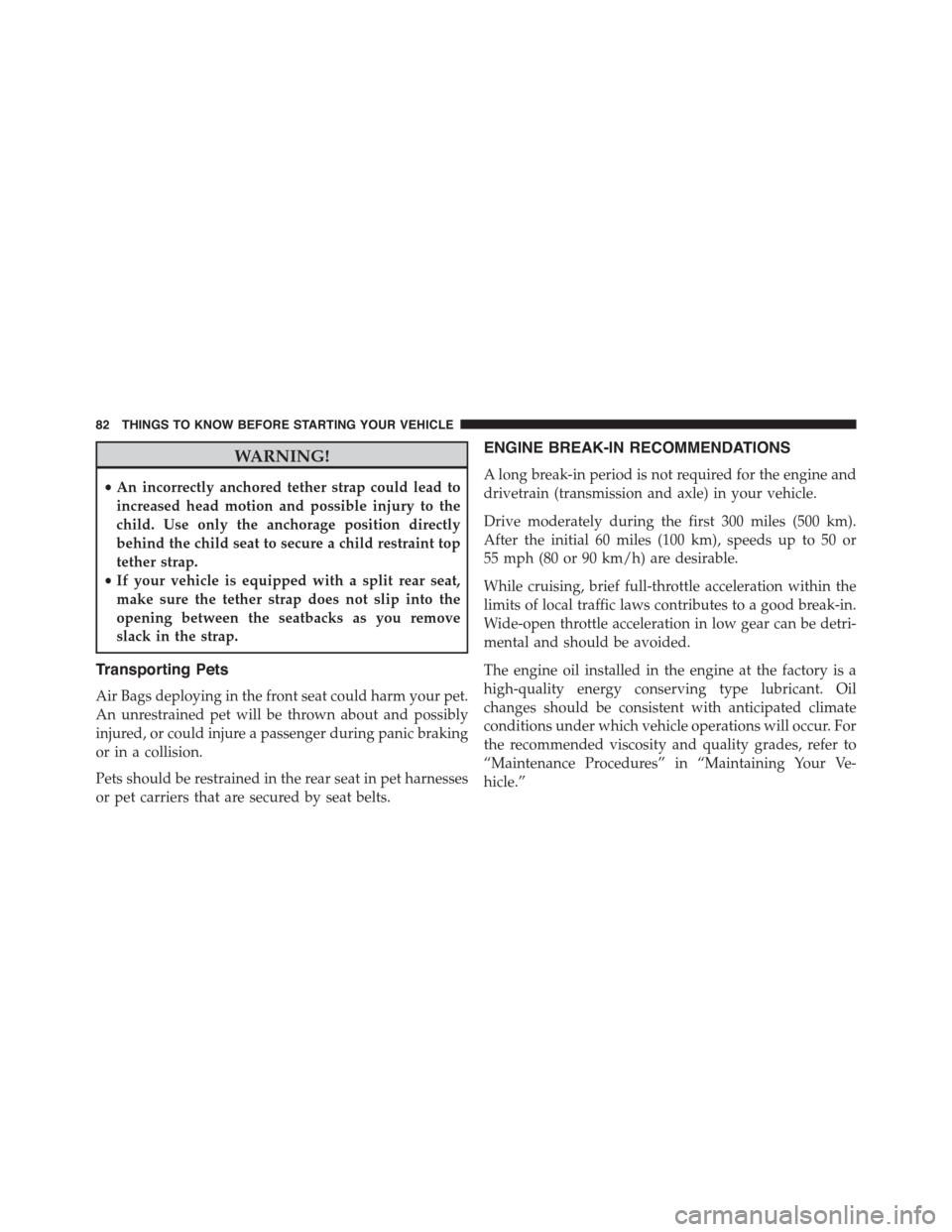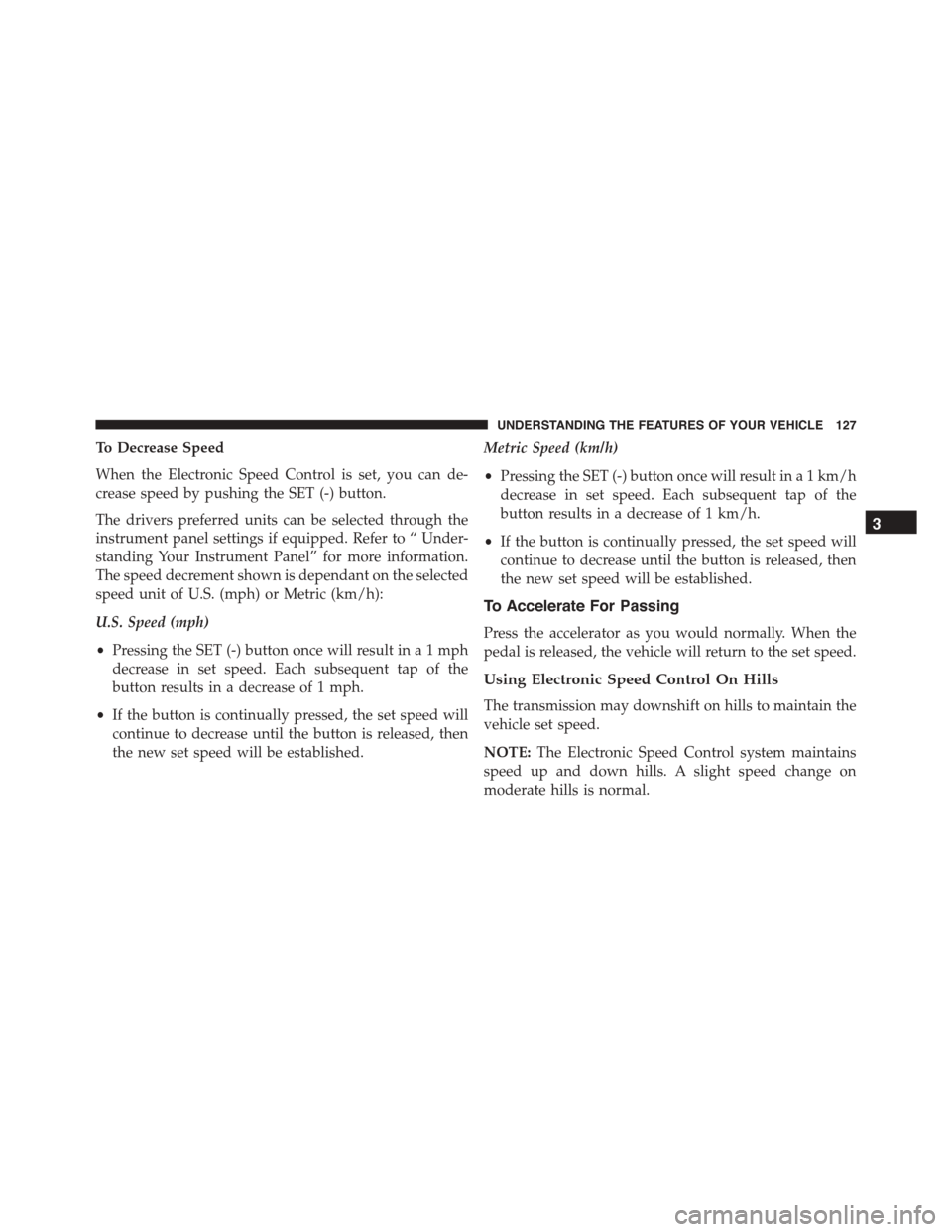Page 13 of 438
A WORD ABOUT YOUR KEYS
The Key Fob contains the Remote Keyless Entry (RKE)
transmitter with an integrated key. To use the mechanical
key simply push the mechanical key release button.
NOTE:The authorized dealer that sold you your vehicle
has the key code numbers for your vehicle locks. These
numbers can be used to order duplicate keys from your
authorized dealer.
Ignition Switch
The ignition switch can be turned to three different
positions:
•STOP: engine off, key can be removed. Some electrical
devices (e.g. sound system, central door locking sys-
tem, etc.) can operate;
NOTE:In vehicles equipped with automatic transmis-
sions, the transmission must be in PARK before the key
can be removed.
Mechanical Key Release Button
2
THINGS TO KNOW BEFORE STARTING YOUR VEHICLE 11
Page 15 of 438

WARNING!
•Before exiting a vehicle, always apply the parking
brake, shift the transmission into PARK and re-
move the Key Fob from the vehicle. When leaving
the vehicle, always lock your vehicle.
•Never leave children alone in a vehicle, or with
access to an unlocked vehicle.
•Allowing children to be in a vehicle unattended is
dangerous for a number of reasons. A child or
others could be seriously or fatally injured. Chil-
dren should be warned not to touch the parking
brake, brake pedal or the gear selector.
•Do not leave the Key Fob in or near the vehicle, or
in a location accessible to children. A child could
operate power windows, other controls, or move
the vehicle.
(Continued)
WARNING!(Continued)
•Do not leave children or animals inside parked
vehicles in hot weather. Interior heat build-up may
cause serious injury or death.
CAUTION!
An unlocked car is an invitation to thieves. Always
remove the key from the ignition and lock all the
doors when leaving the vehicle unattended.
Locking Doors With A Key
You can insert the key with either side up. To lock the
door, turn the key to the left. To unlock the door, turn the
key to the right. Refer to “Body Lubrication” in “Main-
taining Your Vehicle” for maintenance procedures.
2
THINGS TO KNOW BEFORE STARTING YOUR VEHICLE 13
Page 21 of 438
NOTE:The line of transmission must not be blocked with
metal objects.
To Unlock The Doors And Liftgate
Push and release the UNLOCK button on the RKE
transmitter once to unlock the driver ’s door or twice,
within five seconds, to unlock all doors and the liftgate.
The turn signal lights will flash to acknowledge the
unlock signal. The illuminated entry system will also
turn on.
To Lock The Doors And Liftgate
Push and release the LOCK button on the RKE transmit-
ter to lock all doors and the liftgate. The turn signal lights
will flash and the horn will chirp to acknowledge the
signal.Remote Keyless Entry Transmitter With Mechanical Key
Release Button
2
THINGS TO KNOW BEFORE STARTING YOUR VEHICLE 19
Page 25 of 438

NOTE:With central locking active (LED ON), opening
one of the front doors, it is possible to perform a central
unlocking (LED OFF). With central locking active (LED
ON), in order to open one of the rear passenger doors, it
is necessary pulling the internal door handle twice. With
one of the rear door open (LED OFF), the unlocking is
performed only for that door, not for all the vehicle.
To unlock the front doors, pull the inside door handle to
the first detent. If the rear doors are locked, you must pull
the door handle once to unlock the door and pull the
door handle a second time to open the door.
WARNING!
•Do not leave children or animals inside parked
vehicles in hot weather. Interior heat build-up may
cause serious injury or death.
(Continued)
WARNING!(Continued)
•For personal security and safety in the event of a
collision, lock the vehicle doors as you drive as
well as when you park and leave the vehicle.
•Before exiting a vehicle, always turn the vehicle
OFF, apply the parking brake, shift the automatic
transmission into PARK or the manual transmis-
sion into REVERSE, and remove the Key Fob from
the ignition. When leaving the vehicle, always lock
your vehicle.
•Never leave children alone in a vehicle, or with
access to an unlocked vehicle.
(Continued)
2
THINGS TO KNOW BEFORE STARTING YOUR VEHICLE 23
Page 26 of 438

WARNING!(Continued)
•Allowing children to be in a vehicle unattended is
dangerous for a number of reasons. A child or
others could be seriously or fatally injured. Chil-
dren should be warned not to touch the parking
brake, brake pedal or the transmission gear selec-
tor.
•Do not leave the Key Fob in or near the vehicle, or
in a location accessible to children. A child could
operate power windows, other controls, or move
the vehicle.
CAUTION!
An unlocked vehicle is an invitation to thieves.
Always remove the key from the ignition and lock all
of the doors when leaving the vehicle unattended.
Doors Lock With One Or More Doors Open
It is possible locking the vehicle through the RKE,
internal button or external key pawl, also if one or more
doors are open. At lock command request, LED is
switched ON. At closing of the last door, the vehicle
maintains the central locking status if key is not inserted
in Ignition Device, otherwise the vehicle will be unlocked
and the LED will be switched OFF.
NOTE:If the key is not inserted in the ignition switch,
but is inside the vehicle, the system does not recognize
the presence of the key and after the closing of last door,
the vehicle remains locked.
Auto — Relocking (Only For Rear Doors)
With the vehicle locked and all doors closed (LED ON), if
a passenger opens one of the rear doors (LED OFF), as
soon as the door is closed, it will be locked again (LED
ON).
24 THINGS TO KNOW BEFORE STARTING YOUR VEHICLE
Page 84 of 438

WARNING!
•An incorrectly anchored tether strap could lead to
increased head motion and possible injury to the
child. Use only the anchorage position directly
behind the child seat to secure a child restraint top
tether strap.
•If your vehicle is equipped with a split rear seat,
make sure the tether strap does not slip into the
opening between the seatbacks as you remove
slack in the strap.
Transporting Pets
Air Bags deploying in the front seat could harm your pet.
An unrestrained pet will be thrown about and possibly
injured, or could injure a passenger during panic braking
or in a collision.
Pets should be restrained in the rear seat in pet harnesses
or pet carriers that are secured by seat belts.
ENGINE BREAK-IN RECOMMENDATIONS
A long break-in period is not required for the engine and
drivetrain (transmission and axle) in your vehicle.
Drive moderately during the first 300 miles (500 km).
After the initial 60 miles (100 km), speeds up to 50 or
55 mph (80 or 90 km/h) are desirable.
While cruising, brief full-throttle acceleration within the
limits of local traffic laws contributes to a good break-in.
Wide-open throttle acceleration in low gear can be detri-
mental and should be avoided.
The engine oil installed in the engine at the factory is a
high-quality energy conserving type lubricant. Oil
changes should be consistent with anticipated climate
conditions under which vehicle operations will occur. For
the recommended viscosity and quality grades, refer to
“Maintenance Procedures” in “Maintaining Your Ve-
hicle.”
82 THINGS TO KNOW BEFORE STARTING YOUR VEHICLE
Page 129 of 438

To Decrease Speed
When the Electronic Speed Control is set, you can de-
crease speed by pushing the SET (-) button.
The drivers preferred units can be selected through the
instrument panel settings if equipped. Refer to “ Under-
standing Your Instrument Panel” for more information.
The speed decrement shown is dependant on the selected
speed unit of U.S. (mph) or Metric (km/h):
U.S. Speed (mph)
•Pressing the SET (-) button once will result ina1mph
decrease in set speed. Each subsequent tap of the
button results in a decrease of 1 mph.
•If the button is continually pressed, the set speed will
continue to decrease until the button is released, then
the new set speed will be established.
Metric Speed (km/h)
•Pressing the SET (-) button once will result in a 1 km/h
decrease in set speed. Each subsequent tap of the
button results in a decrease of 1 km/h.
•If the button is continually pressed, the set speed will
continue to decrease until the button is released, then
the new set speed will be established.
To Accelerate For Passing
Press the accelerator as you would normally. When the
pedal is released, the vehicle will return to the set speed.
Using Electronic Speed Control On Hills
The transmission may downshift on hills to maintain the
vehicle set speed.
NOTE:The Electronic Speed Control system maintains
speed up and down hills. A slight speed change on
moderate hills is normal.
3
UNDERSTANDING THE FEATURES OF YOUR VEHICLE 127
Page 130 of 438

On steep hills, a greater speed loss or gain may occur so
it may be preferable to drive without Electronic Speed
Control.
WARNING!
Electronic Speed Control can be dangerous where the
system cannot maintain a constant speed. Your ve-
hicle could go too fast for the conditions, and you
could lose control and have an accident. Do not use
Electronic Speed Control in heavy traffic or on roads
that are winding, icy, snow-covered or slippery.
REAR PARK ASSIST — IF EQUIPPED
The Rear Park Assist system provides an audible indica-
tion of the distance between the rear fascia/bumper and
a detected obstacle when backing up, e.g. during a
parking maneuver. Refer to the “Park Assist System
Usage Precautions” for the limitations of this system and
recommendations.
Rear Park Assist is automatically activated when the
transmission is placed into REVERSE. As the distance
from an obstacle behind the vehicle decreases, the au-
dible alert becomes more frequent.
Interaction With Trailer Towing
The Rear Park Assist system is automatically deactivated
when a trailer is hitched to the vehicle. The system will be
automatically activated as soon as the trailer is removed.
128 UNDERSTANDING THE FEATURES OF YOUR VEHICLE